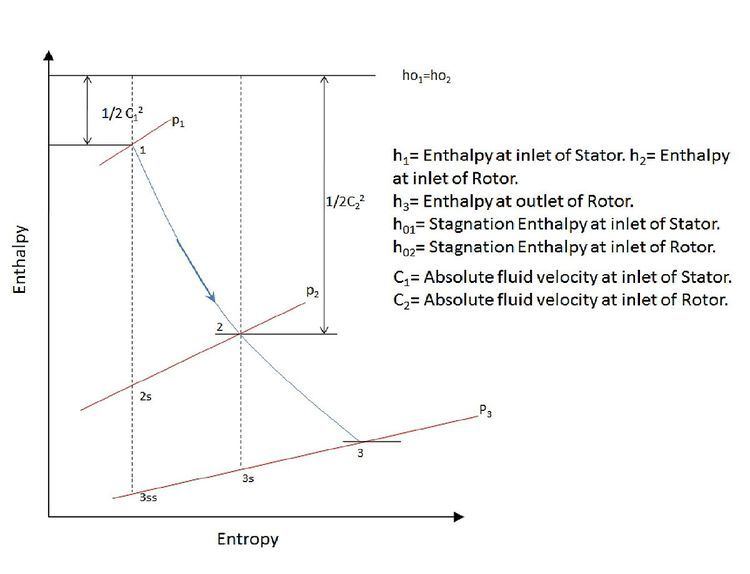 | ||
In turbomachinery, Degree of reaction or reaction ratio (R) is defined as the ratio of static pressure drop in the rotor to the static pressure drop in the stage or as the ratio of static enthalpy drop in the rotor to the static enthalpy drop in the stage.
Contents
- Relation
- Choice of reaction R and effect on efficiency
- 50 reaction
- Reaction less than 50
- Reaction more than 50
- Reaction zero
- References
Degree of reaction (R) is an important factor in designing the blades of a turbine, compressors, pumps and other turbo-machinery. It also tells about the efficiency of machine and is used for proper selection of a machine for a required purpose.
Various definitions exist in terms of enthalpies, pressures or flow geometry of the device. In case of turbines, both impulse and reaction machines, Degree of reaction (R) is defined as the ratio of energy transfer by the change in static head to the total energy transfer in the rotor i.e.
For a gas turbine or compressor it is defined as the ratio of isentropic heat drop in the moving blades (i.e. the rotor) to the sum of the isentropic heat drops in the fixed blades(i.e. the stator) and the moving blades i.e.
In pumps, degree of reaction deals in static and dynamic head. Degree of reaction is defined as the fraction of energy transfer by change in static head to the total energy transfer in the rotor i.e.
Relation
Most turbo machines are efficient to a certain degree and can be approximated to undergo isentropic process in the stage. Hence from
it is easy to see that for isentropic process ∆H ≃ ∆P. Hence it can be implied
The same can be expressed mathematically as:
Where 1 to 3ss in Figure 1 represents the isentropic process beginning from stator inlet at 1 to rotor outlet at 3. And 2 to 3ss is the isentropic process from rotor inlet at 2 to rotor outlet at 3. The velocity triangle (Figure 2.) for the flow process within the stage represents the change in fluid velocity as it flows first in the stator or the fixed blades and then through the rotor or the moving blades. Due to the change in velocities there is a corresponding pressure change.
Another useful definition used commonly uses stage velocities as:
is the enthalpy drop in the rotor and
is the total enthalpy drop. The degree of reaction is then expressed as
For axial machines
The degree of reaction can also be written in terms of the geometry of the turbomachine as obtained by
where
This relation is again very useful when the rotor blade angle and rotor vane angle are defined for the given geometry.
Choice of reaction (R) and effect on efficiency
The Figure 3 alongside shows the variation of total-to-static efficiency at different blade loading coefficient with the degree of reaction. The governing equation is written as
where
50% reaction
The degree of reaction contributes to the stage efficiency and thus used as a design parameter. Stages having 50% degree of reaction are used where the pressure drop is equally shared by the stator and the rotor for a turbine.
This reduces the tendency of boundary layer separation from the blade surface avoiding large stagnation pressure losses.
If R= 1⁄2 then from the relation of degree of reaction,|C| α2 = β3 and the velocity triangle (Figure 4.) is symmetric. The stage enthalpy gets equally distributed in the stage (Figure 5.) . In addition the whirl components at are also same at the inlet of rotor and diffuser.
Reaction less than 50%
Stage having reaction less than half suggest that pressure drop or enthalpy drop in the rotor is less than the pressure drop in the stator for the turbine. The same follows for a pump or compressor as shown in Figure 6. Therefore the stator has a larger contribution to the total work extracted or work done. From the relation for degree of reaction, |C| α2 > β3.
Reaction more than 50%
Stage having reaction more than half suggest that pressure drop or enthalpy drop in the rotor is more than the pressure drop in the stator for the turbine. The same follows for a pump or compressor. Thus in this case the rotor has a larger contribution to the total work extracted or work done. From the relation for degree of reaction,|C| α2 < β3 which is also shown in corresponding Figure 7.
Reaction = zero
This is special case used for impulse turbine which suggest that entire pressure drop in the turbine is obtained in the stator. The stator performs a nozzle action converting pressure head to velocity head and extracting work. It is difficult to achieve adiabatic expansion in the impulse stage, i.e. expansion only in the nozzle, due to irreversibility involved, in actual practice. Figure 8 shows the corresponding enthalpy drop for the reaction = 0 case.
